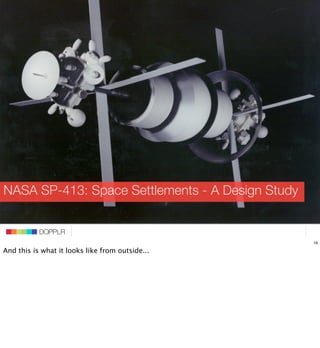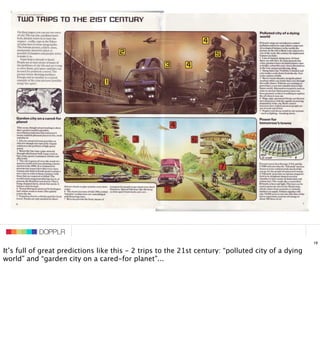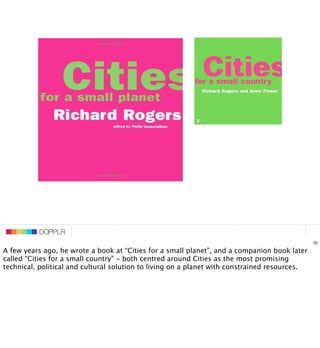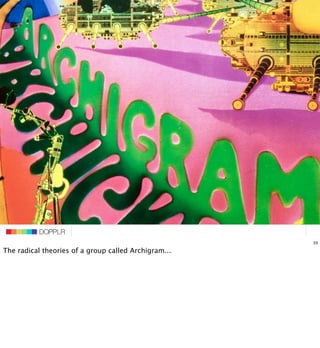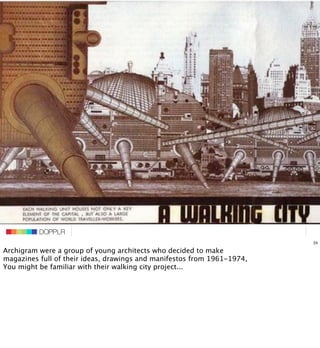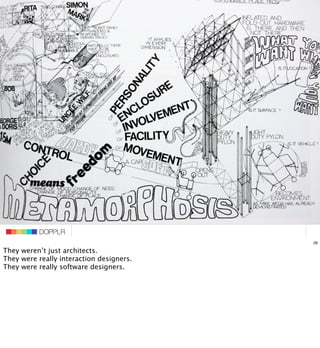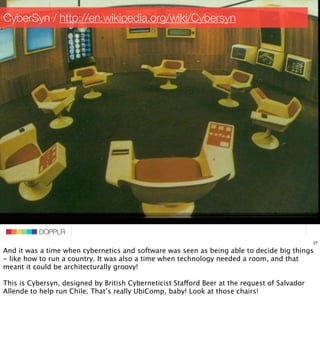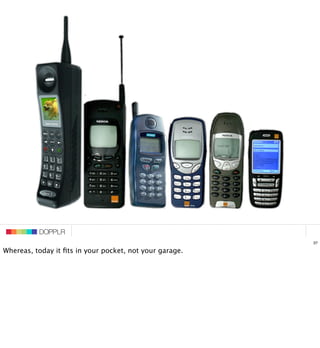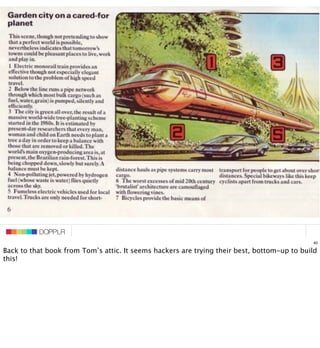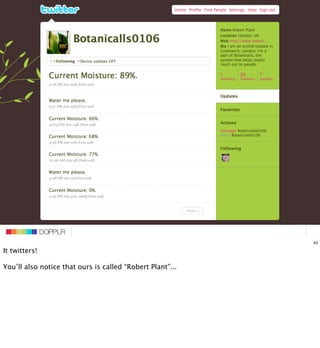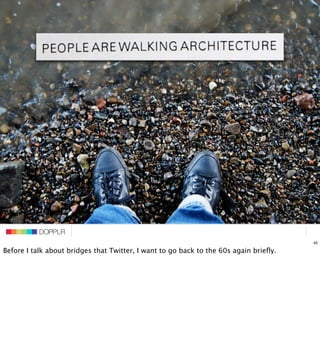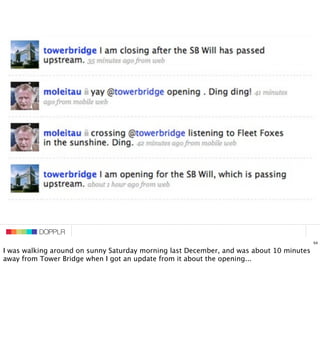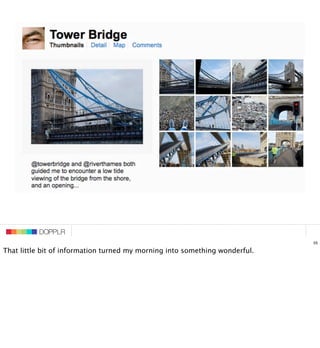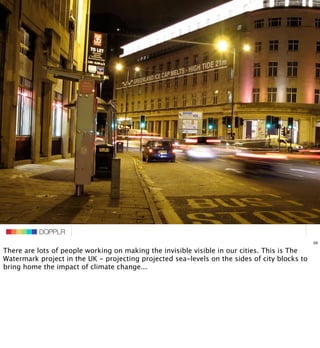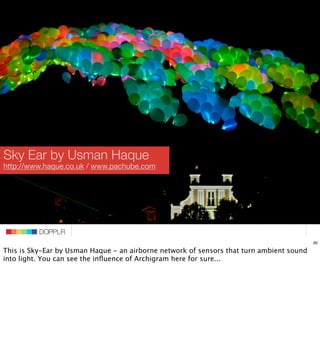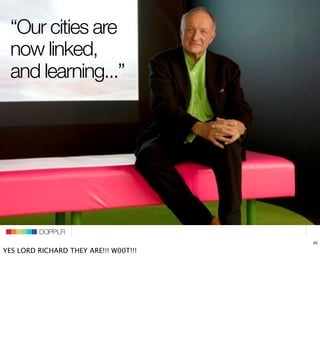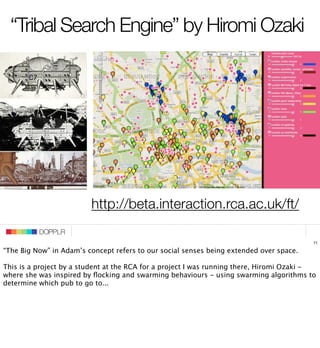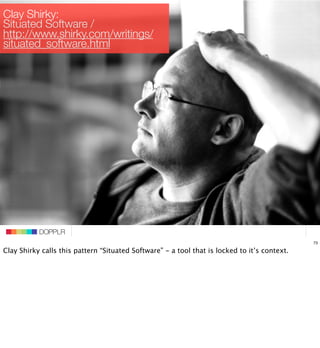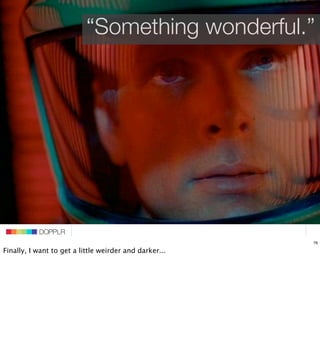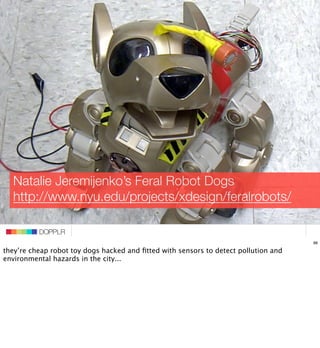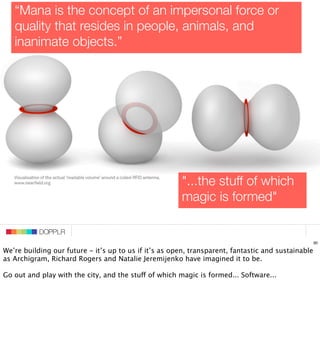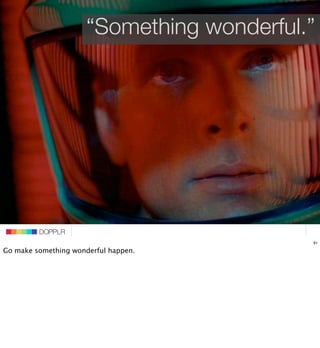The Demon-Haunted World
- 1. The Demon-Haunted World or the past and future of practical city magic Matt Jones / Webstock DOPPLR 41° 17′ 21.48″ S, 174° 46′ 38.28″ E February 2009 DOPPLR DOPPLR 1 Where next? Where next? Where next?
- 2. Hello! DOPPLR DOPPLR DOPPLR 2 Where next? Hello - my name is Matt Jones, and I’m a designer who’s been working on a start-up for two years called Dopplr, and I’m an advisor to a small product design company called Schulze & Webb, who made this tiny version of me that jumps up and down depending on my IM status... Where next? Before that I worked for Nokia doing design research into RFID amongst other things and in the previous millennium I trained to be an architect... Where next? Tash and Mike very graciously said I didn’t have to talk about Dopplr... and as a result I have to give you a warning or three...
- 3. <BLINK> DOPPLR DOPPLR DOPPLR 3 Where next? 1) I may have lost my mind. I think this is the weirdest thing I’ve ever done in public... 2) I’m going to go pretty fast... 3) this presentation contains the <blink> tag - I’ll warn you if you’re sensitive to such things. Where next? Where next?
- 4. DOPPLR DOPPLR DOPPLR 4 Where next? I want to talk about cities, and “practical city magic” City Magic is a phrase I use a lot - I have a whole bunch of things tagged with ‘City Magic’ on delicious. Where next? It comes from a comic book I love called “The Invisibles” by Grant Morrison... Where next?
- 5. DOPPLR DOPPLR DOPPLR 5 Where next? quot;Cities have their own way of talking to you; catch sight of the reflection of a neon sign and it'll spell out a magic word that summons strange dreams. Have you ever seen the word 'IXAT' glowing in the night? That's one of the holy names.quot; Where next? - Tom O'Bedlam, The Invisibles by Grant Morrison Where next?
- 6. DOPPLR DOPPLR DOPPLR 6 Where next? The reason I want to talk about this is informed by these two mega-trends: the rising urbanisation of the planet, and the rapid digitalisation of that urban fabric. The picture is from a talk I did at LIFT06 in Geneva, taken by Timo Arnall. You could probably reconstruct most of the stuff Iʼve ever done or thought-about based upon Where next? this one image. Where next?
- 7. Cities are Nature DOPPLR DOPPLR World Urbanisation Prospects, The 1999 Revision. Source: United Nations, DOPPLR 7 Where next? It is expected that 60 percent of the world population will be urban by 2030, and that most urban growth will occur in less developed countries. We’ve also just gone through the most vigourous period of city building the world has ever seen. What eect will this have on games, play and the imaginations of children growing up when we’re a predominantly city-based species? Where next? Where next?
- 8. Reclaiming futures DOPPLR DOPPLR DOPPLR 8 Where next? In the next 45 minutes or so we’re going to look at three things, broadly. FIRSTLY, reclaiming some optimistic visions of the future we might have lost sight of i.e. Where’s my Jet Pack? HERE’S YOUR JET PACK. Where next? Where next?
- 9. DOPPLR future Making the DOPPLR DOPPLR 9 Where next? SECONDLY, ways in which hackers and designers are making re-configured versions of some of those futures-past. Where next? Where next?
- 10. “Something wonderful.” DOPPLR DOPPLR DOPPLR 10 Where next? and lastly, some wild proclamations about the magical future we’re weaving... Where next? Where next?
- 11. DOPPLR DOPPLR DOPPLR 11 Where next? And that’s kind of the “dark matter” at the centre of both things: software. If you’re sitting comfortably, then I’ll begin... Where next? Where next?
- 12. Reclaiming futures DOPPLR DOPPLR DOPPLR 12 Where next? In order to figure some of this out, let’s go back to the future. Where next? Where next?
- 13. Further back! DOPPLR DOPPLR DOPPLR 13 Where next? We’re going to have to go quite far back... to the 60s... Where next? Where next?
- 14. DOPPLR DOPPLR DOPPLR 14 Where next? I’ve been reading a lot about the post-war and cold-war period lately... Where next? Where next?
- 15. DOPPLR DOPPLR DOPPLR 15 Where next? And, I’m a child of the 70’s. I grew up with books full of images like this. This is a Bernal Sphere: a hypothetical design for a space colony generated by a group from NASA and Stanford University in 1975-1976 Where next? Where next?
- 16. DOPPLR NASA SP-413: Space Settlements - A Design Study DOPPLR DOPPLR 16 Where next? And this is what it looks like from outside... Where next? Where next?
- 17. DOPPLR DOPPLR DOPPLR 17 Where next? And I grew up pouring over books like this one. I’m incredibly grateful to Tom Coates for sharing his scans of his copy of the book (perhaps the fact we both had the same book growing up will become apparent once you’ve seen both our talks...) Where next? Where next?
- 18. DOPPLR DOPPLR DOPPLR 18 Where next? It’s full of great predictions like this - 2 trips to the 21st century: “polluted city of a dying world” and “garden city on a cared-for planet”... Where next? Where next?
- 19. DOPPLR DOPPLR DOPPLR 19 Where next? And, I grew up (sort of) went to uni and trained to be an architect. The web came along and I kind of got distracted, but a lot of the work I’ve been doing in the last few years has drawn me back to that world - of place and cities and urban design, especially where it overlaps with technology. Where next? This is Richard Rogers, one of the most well-known architects in the world, and a prominent member of the British Establishment. He’s even a LORD! Where next?
- 20. DOPPLR DOPPLR DOPPLR 20 Where next? A few years ago, he wrote a book at “Cities for a small planet”, and a companion book later called “Cities for a small country” - both centred around Cities as the most promising technical, political and cultural solution to living on a planet with constrained resources. Where next? Where next?
- 21. “Our cities are now linked, and learning...” DOPPLR DOPPLR DOPPLR 21 Where next? Late last year, I went to a talk by Lord Rogers, where he said something quite evocative. That our cities are increasingly linked, and learning. As a sound-bite - this was more eective a time-machine than the DeLorean. Where next? Where next?
- 22. DOPPLR DOPPLR DOPPLR 22 Where next? Because, back in the 60’s when he wasn’t a Lord - Richard Rogers was a radical architect reconfiguring the city with buildings like the Pompidou Centre in Paris, based on radical theories of cybernetics, space, social-networks, robotics and space stations... Where next? Where next?
- 23. DOPPLR DOPPLR DOPPLR 23 Where next? The radical theories of a group called Archigram... Where next? Where next?
- 24. DOPPLR DOPPLR DOPPLR 24 Where next? Archigram were a group of young architects who decided to make magazines full of their ideas, drawings and manifestos from 1961-1974, You might be familiar with their walking city project... Where next? Where next?
- 25. http://bldgblog.blogspot.com/ DOPPLR DOPPLR DOPPLR 25 Where next? Their influence was far greater than the number of buildings they actually got built (the golf course on the aircraft carrier isn’t by them, I found it on the awesome bldgblog.com but you can see their influence...) Where next? Where next?
- 26. DOPPLR DOPPLR DOPPLR 26 Where next? They weren’t just architects. They were really interaction designers. They were really software designers. Where next? Where next?
- 27. CyberSyn / http://en.wikipedia.org/wiki/Cybersyn DOPPLR DOPPLR DOPPLR 27 Where next? And it was a time when cybernetics and software was seen as being able to decide big things - like how to run a country. It was also a time when technology needed a room, and that meant it could be architecturally groovy! This is Cybersyn, designed by British Cyberneticist Staord Beer at the request of Salvador Where next? Allende to help run Chile. That’s really UbiComp, baby! Look at those chairs! Where next?
- 28. DOPPLR DOPPLR DOPPLR 28 Where next? Archigram thought of behaviour as the raw material they were building with Where next? Where next?
- 29. DOPPLR DOPPLR DOPPLR 29 Where next? And systems and services as the things that would enable behaviour, rather than buildings... Where next? Where next?
- 30. DOPPLR DOPPLR DOPPLR 30 Where next? Personal technologies instead of buildings... (can you see a theme building??) Where next? Where next?
- 31. DOPPLR DOPPLR DOPPLR 31 Where next? They even used the term “Social Software” back in 1972! That blew me away when I found that out this week researching my talk. Where next? Where next?
- 32. DOPPLR DOPPLR DOPPLR 32 Where next? Essentially they were user-centred designers, working with technology to create humane exciting environments with technology... with a liberal dash of 60’s psychedelia... Where next? Where next?
- 33. DOPPLR DOPPLR DOPPLR 33 Where next? They saw that software was going to change our environment in profound ways. The ghost was in the machine, and the machine was the city. Where next? Where next?
- 34. DOPPLR Are we there yet? DOPPLR DOPPLR 34 Where next? But before you write them o as techno-optimist loons, they didn’t see technology and systems as a panacea. I really like this quote: “We shall really get somewhere when it has all cooled o a little, ad hard and soft become relative to each other rather than opposition” Where next? Are we there yet? Where next?
- 35. DOPPLR Chris Heathcote / http://antimega.textdriven.com/antimega/ 2009/01/20/cheer-up-its-archigram DOPPLR DOPPLR 35 Where next? My friend Chris Heathcote thinks so - I used to work with Chris at Nokia and he’s a fantastic source of critical thinking about technology, place and the city. He recently wrote a great blog post about how our urban technology has finally caught up with Archigram’s thinking... Where next? Where next?
- 36. DOPPLR DOPPLR DOPPLR 36 Where next? But, as right as they may have been in the broad strokes, predicting the future is notoriously dificult, even if you are on extremely good drugs. For instance, looking at a lot of Archigram’s schemes, it’s plain to see what they think is the ultimate technology of personal freedom. Where next? Where next?
- 37. DOPPLR DOPPLR DOPPLR 37 Where next? Whereas, today it fits in your pocket, not your garage. Where next? Where next?
- 38. BOW! DOPPLR DOPPLR DOPPLR 38 Where next? The car changed the development of the city irreversibly in the 20th century. I’d claim that mobiles will do the same in the 21st. Where next? Where next?
- 39. DOPPLRthe future Making DOPPLR DOPPLR 39 Where next? And it’s from that point of view I’d like to take you through a few urban futures that people are constructing right now, with some links back to Archigram and their contemporaries. Where next? Where next?
- 40. DOPPLR DOPPLR DOPPLR 40 Where next? Back to that book from Tom’s attic. It seems hackers are trying their best, bottom-up to build this! Where next? Where next?
- 41. DOPPLR INFO DOPPLR DOPPLR 41 Where next? This is another favourite book of mine at the moment, On Guerilla Gardening... It’s about reclaiming space in the city through gardening it without permission. It seems to me like there are a bunch of hackers reclaiming information from the city and gardening it without permission... Where next? Where next?
- 42. DOPPLR Botanicalls.com DOPPLR DOPPLR 42 Where next? There’s also a bottom-up maker movement, hacking hardware and covering the planet in sensors. You might have heard some of this in Matt Biddulph’s talk, and you’ll certainly hear a lot more of it in Tom’s talk I think. Where next? This is the Botanicall’s kit I made over Christmas (first time I’d soldered anything in about 20 Where next? years, enormous fun!) it connects a pot-plant of ours to the internet and when it’s moisture sensors detect it needs something...
- 43. DOPPLR DOPPLR DOPPLR 43 Where next? It twitters! You’ll also notice that ours is called “Robert Plant”... Where next? Where next?
- 44. DOPPLR DOPPLR DOPPLR 44 Where next? But there are some geeks wiring up bigger things... Where next? Where next?
- 45. DOPPLR DOPPLR DOPPLR 45 Where next? Before I talk about bridges that Twitter, I want to go back to the 60s again briefly. Where next? Where next?
- 46. “...the study of the precise laws and specific effects of the geographical environment, consciously organised or not, on the emotions and behaviour of individuals.” DOPPLR DOPPLR DOPPLR 46 Where next? This is Guy DeBord. French philosopher and head troublemaker of the Situationist Internationale, who apart from doing all of that good 60’s Parisian stu of getting the girls, drinking the wine, smoking the galloise and getting bashed by riot police, also coined the term “Psychogeography” he defined it as: “...the study of the precise laws and specific effects of the geographical environment, consciously organised or not, on the Where next? emotions and behaviour of individuals.” Where next?
- 47. “...a whole toy box full of playful, inventive strategies for exploring cities...just about anything that takes pedestrians off their predictable paths and jolts them into a new awareness of the urban landscape” DOPPLR DOPPLR DOPPLR 47 Where next? But this alternate definition cited on wikipedia fits almost exactly, for me... Where next? Where next?
- 48. “...a whole toy box full of playful, inventive strategies for exploring cities...” DOPPLR DOPPLR DOPPLR 48 Where next? as a description of what we carry around in our pockets - our use and experience of the city is being profoundly changed by these things. Where next? Where next?
- 49. DOPPLR DOPPLR DOPPLR 49 Where next? They are psychogeographic, magic wands. Where next? Where next?
- 50. DOPPLR DOPPLR DOPPLR 50 Where next? ...back to Tower Bridge. Where next? Where next?
- 51. Tom Armitage / http://www.infovore.org DOPPLR DOPPLR DOPPLR 51 Where next? My friend Tom Armitage did some guerilla info gardening and scraped the data feed of when Tower Bridge opens and closes - and created a twitter account that spits that out... Where next? Where next?
- 52. DOPPLR DOPPLR DOPPLR 52 Where next? Where next? Where next?
- 53. DOPPLR DOPPLR DOPPLR 53 Where next? You’ll notice that Tom’s also doing a bit of city-scale ventriloquism with @TowerBridge, and... that all of it’s friends are Statues, NASA Probes or Radio Telescopes that twitter... I’m kind of finding the best people on twitter aren’t people... Where next? Where next?
- 54. DOPPLR DOPPLR DOPPLR 54 Where next? I was walking around on sunny Saturday morning last December, and was about 10 minutes away from Tower Bridge when I got an update from it about the opening... Where next? Where next?
- 55. DOPPLR DOPPLR DOPPLR 55 Where next? That little bit of information turned my morning into something wonderful. Where next? Where next?
- 56. Making the invisible,visible DOPPLR DOPPLR DOPPLR 56 Where next? One extension of this, is increasingly we are able to see previously invisible behaviours from ʻthe real worldʼ and apply social tools to them. “Anything essential is invisible to the eye”. This is “Nuage Vert” - a project in Helsinki (where half of Dopplr are based) wear a laser picks out the pollution coming from a power station. Eerie, beautiful and perhaps, useful to the city... Where next? Where next?
- 57. “The way the street feels may soon be defined by what cannot be seen with the naked eye.” Dan Hill, Street as Platform / http://cityofsound.com DOPPLR DOPPLR DOPPLR 57 Where next? Two people doing more thinking about this than most, and if your interested in the area, I’d recommend you go read their stu asap are Dan Hill, who wrote an epic blog post last year called “The Street as Platform”... Where next? Where next?
- 58. “The bottom line is a city that responds to the behaviour of its users in something close to real time, and in turn begins to shape DOPPLR that behaviour.” Adam Greenfield: The City Is Here For You To Use DOPPLR http://speedbird.wordpress.com/ DOPPLR 58 Where next? And Adam Greenfield - who wrote an excellent book called “Everyware” about designing in times where everything and everywhere has software embedded in it... and is about to release a book called “The city is here for you to use” from which comes this quote. Again, we’re not so far away from what Archigram were examining. Behaviour and Where next? Information as the raw material to design cities with as much as steel, glass and concrete. Where next?
- 59. DOPPLR DOPPLR DOPPLR 59 Where next? There are lots of people working on making the invisible visible in our cities. This is The Watermark project in the UK - projecting projected sea-levels on the sides of city blocks to bring home the impact of climate change... Where next? Where next?
- 60. Sky Ear by Usman Haque http://www.haque.co.uk / www.pachube.com DOPPLR DOPPLR DOPPLR 60 Where next? This is Sky-Ear by Usman Haque - an airborne network of sensors that turn ambient sound into light. You can see the influence of Archigram here for sure... Where next? Where next?
- 61. Practical Psychogeography Christian Nold, http://www.biomapping.net DOPPLR DOPPLR DOPPLR 61 Where next? Christian Nold’s Biomapping.org overlays readings from a ‘stress-sensor’ worn by someone wandering the city. Where next? Where next?
- 62. “...the study of the precise laws and specific effects of the geographical environment, consciously organised or not, on the emotions and behaviour of individuals.” DOPPLR DOPPLR DOPPLR 62 Where next? Again, the sensors we are all carrying around the city are creating everyday psychogeography a reality. More on this in Tom’s talk I’m sure... Where next? Where next?
- 63. New Maps http://www.openstreetmap.org DOPPLR DOPPLR DOPPLR 63 Where next? With these new senses we can make new sense of what’s around us. New maps. This is the work of openstreetmap.org who gave a small group of people GPS units for a small amount of time and created this wonderful image of the viscera of London’s flows and connections. Where next? Where next?
- 64. Neurones DOPPLR DOPPLR DOPPLR 64 Where next? You can’t not look at something like that, and see biological, cybernetic parallels... Where next? Where next?
- 65. “Our cities are now linked, and learning...” DOPPLR DOPPLR DOPPLR 65 Where next? YES LORD RICHARD THEY ARE!!! W00T!!! Where next? Where next?
- 66. DOPPLR DOPPLR DOPPLR 66 Where next? We’re heard from Adrian about Everyblock. Where next? Where next?
- 67. DOPPLR DOPPLR DOPPLR 67 Where next? And similar projects in the UK like fixmystreet.com Where next? Where next?
- 68. DOPPLR DOPPLR DOPPLR 68 Where next? and streetwire.org are surfacing hyper-local information... Where next? Where next?
- 69. DOPPLR DOPPLR DOPPLR 69 Where next? Again, visualisations help us picture the local information fields around the city such as this beautiful piece by Shawn Allen of Stamen showing San Francisco as a mesh of trees, crimes and cabs. Where next? Where next?
- 70. DOPPLRand the Long Here The Big Now DOPPLR DOPPLR 70 Where next? Our future city senses might be more like those of rhinos. Their amazing sense of smell means that their ‘pub conversations’ can last many months over many square miles... Adam Greenfield has talked about the Big Now and the Long Here, in a reconfiguration of Brian Eno’s “the Big here and the long now” - the long here being the ‘rhinoesque’ build-up Where next? of media in place... where media = rhino poop. Where next?
- 71. “Tribal Search Engine” by Hiromi Ozaki DOPPLR http://beta.interaction.rca.ac.uk/ft/ DOPPLR DOPPLR 71 Where next? “The Big Now” in Adam’s concept refers to our social senses being extended over space. This is a project by a student at the RCA for a project I was running there, Hiromi Ozaki - where she was inspired by flocking and swarming behaviours - using swarming algorithms to determine which pub to go to... Where next? Where next?
- 72. DOPPLR DOPPLR DOPPLR 72 Where next? On another scale, that of neighbourhoods... Hacking together software tools to deal with specific place - more guerilla info gardening, like Paul Hammond’s “minimuni” tool he wrote for his iphone to work out when the next bus is coming. As he says - he oers no warranty outside of the 6 mins radius from his house. Where next? Where next?
- 73. Clay Shirky: Situated Software / http://www.shirky.com/writings/ situated_software.html DOPPLR DOPPLR DOPPLR 73 Where next? Clay Shirky calls this pattern “Situated Software” - a tool that is locked to it’s context. Where next? Where next?
- 74. “Always design a thing by considering it in its next larger context ...a chair in a room, a room in a house, a house in an DOPPLRenvironment, an environment in a DOPPLR city plan.” DOPPLR 74 Where next? Another architect, from Finland in the beginning of the 20th C, Eliel Saarinen gives us some food for thought about this... Imagine a lot of these small pieces of situated software loosely joined... and you’ve got a bottom-up, open-source city full of software... Where next? Where next?
- 75. “Our cities are now linked, and learning...” DOPPLR DOPPLR DOPPLR 75 YEAH!!!!next? Where Where next? Where next?
- 76. “Something wonderful.” DOPPLR DOPPLR DOPPLR 76 Where next? Finally, I want to get a little weirder and darker... Where next? Where next?
- 77. “From the beginning of his literary career, Machen espoused a mystical belief that the humdrum ordinary world hid a more mysterious and strange world beyond. His gothic and decadent works of the 1890s concluded that the lifting of this veil could lead to madness, sex, or DOPPLR death, and usually a combination of all three.” DOPPLR DOPPLR 77 Where next? This is another Welshman, Arthur Machen, who investigated the common human belief that there are invisible forces at play behind the ‘ordinary world’ Where next? Where next?
- 78. DOPPLR Arphids! DOPPLR DOPPLR 78 Where next? By which of course he meant RFID! The mark of the devil!!! (not really...) Where next? Where next?
- 79. DOPPLR DOPPLR DOPPLR 79 Where next? Work by Timo Arnall, Einar Sneve, Matt Webb and Jack Schulze. Where next? Where next?
- 80. Robot Readable Planet DOPPLR DOPPLR DOPPLR 80 Where next? Instead of making robots smarter, more accommodating of our world and our senses - what if by covering the world with data, RFIDs etc - we’re creating a robot-readable planet, that’s opaque to our naked un-augmented eye? Where next? Where next?
- 81. “Has Needs” by James Chambers http://beta.interaction.rca.ac.uk/ft/ DOPPLR DOPPLR DOPPLR 81 Where next? This is another project by a student I was working with at the RCA, James Chambers - it’s a sensor like Botanicalls, but crucially this one doesn’t send it’s messages to you - but to everyone else you know, making you cave into social pressure... If you carry on your wanton ways, then it’ll post itself to craig’s list or freecycle and ask to be rescued! Where next? Where next?
- 82. DOPPLR Daemons DOPPLR DOPPLR 82 Where next? And, it’s this thought... about the conversations that will be happening between bridges and plants and cars and everything else non-human that both delights me and gives me the willies, like most magic... The demon-haunted world is something we’ve believed in for most of our time on Earth. It’s Where next? interesting to me that we’re perhaps building it. Where next?
- 83. DOPPLR I, for one welcome our new Xbee overlords DOPPLR DOPPLR 83 Where next? This is an Xbee shield - that I think Matt Biddulph discussed in his talk. Where next? Where next?
- 84. DOPPLR DOPPLR DOPPLR 84 Where next? Xbee is an open-source version of Zigbee - a protocol that connects things together in a mesh at very low power... so that everything can talk to everything else. Zigbee devices are continually waking up and looking for something to talk to... they look for the next thing up the chain... a master or controller... and that then wakes up and looks for the same... like Demons do... Where next? Where next?
- 85. Eloi vs DOPPLR Morlocks DOPPLR DOPPLR 85 Where next? Neal Stephenson, in his essay on technological literacy “In the beginning was the command line” describes passive unaware consumers of technology as Eloi and those in control of keeping them that way as Morlocks... Will we become literate in this demon-haunted world of urban computing, or will we be Where next? unaware Eloi at the mercy of the Morlocks? Where next?
- 86. DOPPLR Dark materials... DOPPLR DOPPLR 86 Where next? Will our demons be extension of ourselves, or extensions of the forces of control? Will they be open and transparent, or dark magical things we barely understand? Where next? Where next?
- 87. DOPPLR Natalie Jeremijenko’s Feral Robot Dogs http://www.nyu.edu/projects/xdesign/feralrobots/ DOPPLR DOPPLR 87 Where next? I’m optimistic, like Archigram. I think the bottom-up, loosely-joined situated software that’s being built will prove faster, nimbler and more useful than anything top-down or monolithic. Where next? A final example in this vein: natalie jeremijenko’s feral robotic dogs... Where next?
- 88. DOPPLR Natalie Jeremijenko’s Feral Robot Dogs http://www.nyu.edu/projects/xdesign/feralrobots/ DOPPLR DOPPLR 88 Where next? they’re cheap robot toy dogs hacked and fitted with sensors to detect pollution and environmental hazards in the city... Where next? Where next?
- 89. Natalie Jeremijenko’s Feral Robot Dogs http://www.nyu.edu/projects/xdesign/feralrobots/ DOPPLR DOPPLR DOPPLR 89 Where next? Natalie goes into communities and takes people through the process of turning cheap toys into powerful visualisers of pollutants in their environments... making the invisible visible... Where next? Where next?
- 90. “Mana is the concept of an impersonal force or quality that resides in people, animals, and inanimate objects.” DOPPLR quot;...the stuff of which magic is formedquot; DOPPLR DOPPLR 90 Where next? We’re building our future - it’s up to us if it’s as open, transparent, fantastic and sustainable as Archigram, Richard Rogers and Natalie Jeremijenko have imagined it to be. Go out and play with the city, and the stu of which magic is formed... Software... Where next? Where next?
- 91. “Something wonderful.” DOPPLR DOPPLR DOPPLR 91 Where next? Go make something wonderful happen. Where next? Where next?
- 92. Thanks Webstock... DOPPLR DOPPLR DOPPLR 92 Where next? Where next? Where next?
















